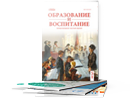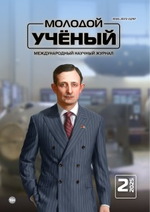The article examines the image of the mother in the works of A. A. Akhmatova, M. I. Tsvetaeva and M. M. Shkapskaya. Conclusions are drawn about the specifics of his disclosure, due to the coincidence of the lyrical heroine and the image of the mother. In addition, the influence of the historical context of the early 20th century on the development of the image of the mother in the lyrics of the Silver Age is revealed.
Key words: Russian poetry of the Silver Age, image of mother, Civil War, image of the Mother of God, image of homeland.
The theme of motherhood is invariably inherent in Russian poetry: it passes through all stages of literature, originating in folklore and remaining a special literary phenomenon to this day. The image of the mother becomes especially demanded in the poetry of the XX century, when it acts as an “emblematic sign of the era” [1, p.3]. Among the representatives of the Silver Age of Russian poetry it was addressed by A. A. Blok, I. A. Bunin, S. A. Esenin, N. A. Klyuev and others. In this article we will turn to the lyrical works about motherhood written by women poets, because this approach allows us to trace the disclosure of this image from the point of view of the inner world of a woman, mother and poet. The largest representatives of the theme of motherhood among the poets of the Silver Age are A. A. Akhmatova, M. I. Tsvetaeva and M. M. Shkapskaya.
A characteristic feature of the lyrics of women poets is the coincidence of the lyrical heroine and the image of the mother, which is the reason for the special cordiality, frankness and confessionality of the poems, most often dedicated to children. In the mature lyrics of Marina Tsvetaeva sounds the speech of a mother in love with her children. My dear, adorable creature, baby — so she addresses her daughter in numerous poems under the title “Ale” of different years. The motifs of memory and maternal guidance are essential for the creation of the image of a mother. The lyrical heroine sees in her daughter an extension of herself, her extraordinary “snake breed” (“Ale”, 1917). The image of the mother is revealed through the prism of the heroine's ideas about what memories of her will remain with her daughter, with the help of a number of artistic details: “hooked nose profile”, eternal laughter, a hundred silver rings on her hand, “divine confusion of papers” [2] (“Ale”, 1919). Thus, M. Tsvetaeva creates not a generalized, but a concrete and autobiographical image of the mother. Otherwise, it is revealed in the cycle “Stihi k synu” (“Poems to the Son”) (1932), in which, according to M. V. Melexetian, “Tsvetaeva-mother, usually very jealous of children, as if bequeaths her son to the motherland”: “Go, my son, to your country... My child who has never seen Russia... Mine? Her — / Child!” [1, p.40] (emphasis added. — O.P.).
In Anna Akhmatova's lyrics of the 1920s, the image of mother is also identical to the lyrical heroine, but is less autobiographical than in Tsvetaeva's, because, according to Eichenbaum's idea of the poet's masks, even the image of mother is such a mask for her, or rather a character created according to epic laws. Instead of maternal tenderness in Akhmatova, the motif of repentance comes to the fore. In the poem “I will be quiet on the pogost...” (“Budu tiho na pogoste…”) (1915), the mother with the realization of guilt turns to the child, anticipating his imminent departure and appealing to the son's memory as the only thing that he will be left of her: “I know, my darling, you can remember little / About me: / I did not scold you, I did not caress you, / I did not take you to communion.” [3]. Moreover, in “Lullaby” (“Kolybel'naya”) (1915), the mother's direct speech contains a harsh confession — “I am a bad mother”. In contrast to the traditional for the genre of the lullaby maternal instructions and thoughts about the future of the child (as in “Cossack Lullaby” by M. Y. Lermontov, 1838), A. Akhmatova's heroine, soothing the crying baby, thinks not about him, but about her husband (“May Saint Egoriy protect / Your father”) and about his bitter fate (“There was grief, there will be grief, / Grief has no end”). In the poem “Where, high, your gypsy boy...” (“Gde, vysokaya, tvoj cyganenok...”) (1914), built in the form of a dialog, the lyricism of the poem “Where, high, your gypsy boy...” sounds. (1914) sounds lyrical confession of a woman unworthy of motherhood: “The share of a mother is a light torture, / I was not worthy of it.” The image of the mother in different poems is constructed with the help of everyday and psychological details: “Only my hands yearn for the burden, / Only his crying I hear in my sleep”, “And the mother in the half-dark hay / Broke her withered fingers / And long searched in the darkness / For a clean bonnet and blanket” (“All night long they did not let me sleep...”, 1909).
The theme of motherhood is central to M. M. Shkapskaya's poetry of the 1920s.The image of the mother in her poems is most often given in a tragic vein: whether it is a deeply personal image of a mother who has lost her unborn child (“My inanimate child...”, 1915, “Children will grow older, more mature...”, 1919), or the image of “Magdalene on the cross” suffering for her son (the collection “Mater dolorosa”, 1921), or a generalized image of a mother, in relation to whom “earthly rules are simple and strict” [4, p.192], and motherhood is compared by her to the ascent to Calvary (“Oh this female Calvary!”, 1921) and she compares motherhood to the ascent to Golgotha (“Oh this female Golgotha!”, 1922). Let us turn to M. Shkapskaya's epithets: the mother in her poetry is tired, orphaned, quiet, tender, silent. Childlessness for a woman turns in M. Shkapskaya's consciousness into a painful and indomitable longing, it is a life “without meeting, but in separation”, a life empty and meaningless: “Invisible threads do not knit you with anyone, / And the days of desolation decay into dead ashes./ With what envy you, light, look / At the mother tired, with a child in her arms”. And with aphoristic characteristic for M. Shkapskaya she asserts that for a woman there is nothing more important than motherhood, and nothing can replace her child: “Oh, poor, how can I help you to live, / And in the dark evening in your empty hands / What sun to put?”
This poem is consonant with Tsvetaev's lines: “I love women, that in battle did not faint, / Who could hold a sword and a spear, — / But I know that only in the captivity of the cradle / Ordinary — female — my happiness! (”In the Luxembourg Garden»). M. Shkapskaya's lyrics are characterized by a prayerful appeal to God and the Blessed Virgin Mary. In the poetic text “Canon of the Mother of God” (1922) the lyrical heroine addresses the Mother of God both as a daughter to the mother of all people, and as a mother to another mother: “We are all Her children, we are all Her daughters, all those by whom tears are shed in this world.... And from Her, the gracious Victim, the Mother of Him who rose from the dead, we ask for our child a fine hair, a ringing voice, and a heart kind to the mother”.
The eternal, archetypal image of the mother in the poetry of the Silver Age is inevitably inscribed in the brutal historical reality, so anxiety and pain for children become the content dominants of the image, and the real-life image of the earthly mother through suffering for her sons is elevated to the images of the motherland and the Mother of God.
References:
- Meleksetyan M. V. The image of the mother in Russian poetry of the 20th century: A. Blok, A. Akhmatova, A. Tvardovsky: dissertation research Ph.D. of Philological Sciences / Meleksetyan M. V. — Moscow, 2009. — 161 p.
- Tsvetaeva M. I. Collected works: In 7 volumes / M. I. Tsvetaeva. Moscow: Ellis Luck, 1994–1995.
- Akhmatova A. A. Collected works: In 6 volumes / A. A. Akhmatova. — Moscow, 1998.
- Maria Shkapskaya. The hour is evening. Poems. / M. Shkapskaya. — St. Petersburg: Limbus Press, 2000. — 192 p.







